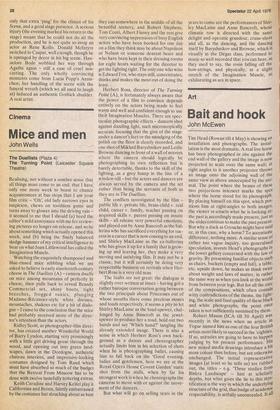Cinema
Mice and men
John Wells
The Duellists (Plaza 4) The Turning Point (Leicester Square Theatre) Realising, not without a sombre sense that all things must come to an end, that I have only one more week to boast to chance acquaintances at bus stops that I am your film critic — 'Oh', old lady narrows eyes in suspicion, chews on toothless gums and' turns away to glower into the driving rain — it seemed to me that I should (a) heed the editor's mild annoyance with me for reviewing pictures no longer on release, and write about something which actually opened this week, and (b) bring the finely balanced sledge-hammer of my critical intelligence to bear on what Joan Littlewood has called the Imagination Muscle.
Watching the exquisitely shampooed and blue-rinsed mice nibbling what we are asked to believe is early nineteenth-century cheese in The Duellists (A) —camera dwells on mice among mountains of perfectly lit cheese, then pulls back to reveal Brandy Commercial set, shiny boots, tight breeches, frogged tunics, plunging Madame-Recamier-style white dresses, moustaches, shakoes etc for a bit of dialogue — I came to the conclusion that the mice had probably received more of the director's attention than the actors.
Ridley Scott, as photographer-film director, has created another Wonderful World of Barry Lyndon, starting very promisingly with a little girl driving geese through the wood, and opening out into green landscapes, dawn in the Dordogne, authentic chateau interiors, and impressive-looking costumes designed by Tom Rand which must have absorbed so much of the budget that the Retreat From Moscow has to be done with twelve tastefully tottering extras.
Keith Caradine and Harvey Keitel play it Californian and Bronx, faintly embarrassed by the costumes but slouching about as best they can somewhere in the middle of all the beautiful scenery, and Robert Stephens, Tom Conti, Albert Finney and the rest give very convincing impressions of busy English actors who have been booked for one day on a film they think may be about Napoleon or Nelson or someone dearest heart and who have been kept in their dressing rooms for eight hours waiting for the director to get the lighting right. The only one who wins is Edward Fox, who stays still, concentrates, thinks and makes the most out of doing the least.
Herbert Ross, director of The Turning Point (A), is fortunately always aware that the power of a film to convince depends entirely on the actors being made to feel warm and well and confident enough to use their Imagination Muscles. There are spectacular photographic effects — dancers shot against dazzling light, such microscopically accurate focusing that the give of the stage under a dancer's feet or the smudging of the polish on the floor is clearly recorded, and one shot of Mikhail Baryshnikov and Leslie Browne dancing in front of a wall of mirrors where the camera should logically be photographing its own reflection but is barely detectable, thanks to the skill of the lighting, as a grey hump in the line of a window-sill —but the actors and dancers are always served by the camera and the set rather than being the servants of both as they are in The Dualists.
The conflicts investigated by the film — public life v. private life, brain-child v. real child, career v. family, teacher passing on acquired skills v. parent passing on innate skills — all release very powerful emotions, and played out by Anne Bancroft as the ballerina who has sacrificed everything for success in a career that is now coming to an end, and Shirley MacLaine as the ex-ballerina who has given it up for a family that is growing up and leaving her, they make a very moving and satisfying film. It may not be a classic, but it will certainly be doing very respectable business on revivals when Herbert Ross is a very old man.
The faults are not great: the dialogue is slightly over-written at times — having got a rather baroque conversation going between the two principals about Princesses out of whose mouths there come precious stones and toads respectively, it seems a pity to let Shirley MacLaine as the load-spewer, challenged by Anne Bancroft as the jewel spewer to produce her a toad, hold out two hands and say 'Which hand?' tangling the already extended image. There is also a sense in which Herbert Ross's own back ground as a dancer and choreographer actually limits him in his selection of shots when he is photographing ballet, causing him to fall back on the 'Good evening, ladies and gentlemen, here we are at the Royal Opera House Covent Garden' static shot from the stalls, when by far his strongest work is when he choreographs the cameras to move with or against the movement of the dancers.
But what will go on selling seats in the
years to come are the performances of Shirley MacLaine and Anne Bancroft, whose climatic row is directed with the same delight and operatic grandeur, crane-shots and all, as the dancing, and the dancing itself by Baryshnikov and Browne, which is visually in the Degas class, performed to music so well recorded that you can hear, as they used to say, the rosin falling off the bow-strings, and physically, at a slight stretch of the Imagination Muscle, as exhilarating as sex in space.


































 Previous page
Previous page